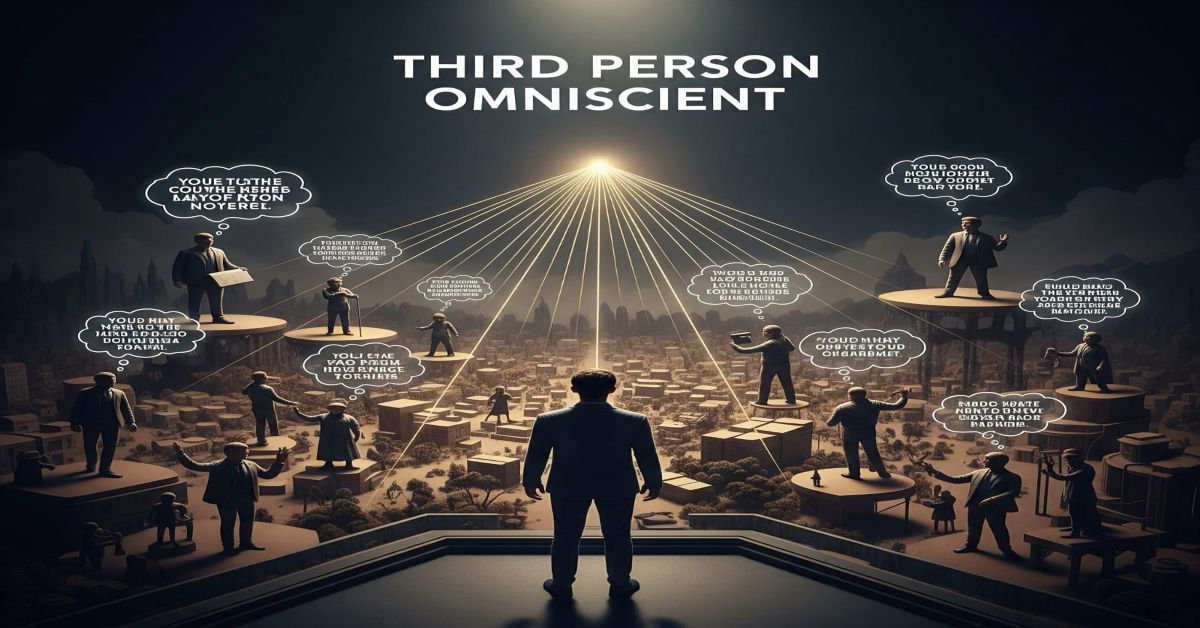Third person omniscient is one of the most powerful storytelling tools in literature. It offers writers the unique ability to move freely through characters minds, reveal hidden emotions and explain events with an authority no character could possess. In this perspective, the narrator is not bound by personal experience but acts as a guide who knows everything about the world and its people. This makes it especially useful for stories that explore multiple plotlines, vast settings or complex emotional landscapes.
At the same time, this point of view requires skillful handling. Because the narrator has so much control, the challenge lies in deciding what to reveal and when to reveal it. The introduction of third person omniscient into any story transforms the reading experience, providing depth, clarity, and layers of meaning that might otherwise remain hidden. It is a perspective that bridges distance and intimacy offering both scope and insight.
Understanding the Narrative Perspective
Third person omniscient is often described as an all-knowing point of view. Unlike limited perspectives, which stay with one character, the omniscient narrator can see into the minds of many characters at once, explore events in different locations, and even provide commentary that shapes the reader’s interpretation. This bird’s-eye view creates a sense of authority, making the narrator not just a storyteller but also a guide to meaning.
What makes this perspective especially engaging is its flexibility. Authors can shift from broad descriptions of entire societies to the intimate thoughts of a single character in a matter of sentences. They can foreshadow future events, reflect on moral themes, or reveal information that characters themselves do not yet know. By doing so, the third person omniscient point of view expands the possibilities of storytelling, making it one of the most versatile and enduring approaches in literature.
Origins and Historical Use of Third Person Omniscient
The origins of third person omniscient can be traced back to the oral traditions of ancient civilizations. Storytellers often spoke from a perspective that seemed to have divine authority, recounting events that occurred across vast landscapes and within the hearts of heroes. Epics like Homer’s Iliad and Odyssey reflected this approach, presenting stories with a sense of godlike vision and universal knowledge.
By the time novels gained prominence in the eighteenth and nineteenth centuries, this perspective became central to literature. Writers like Charles Dickens and Leo Tolstoy perfected the craft, using omniscient narration to explore sprawling societies and deeply personal struggles simultaneously. These authors created works that blended social commentary with psychological insight, demonstrating the immense power of the omniscient voice. Although narrative fashions have shifted since then, the technique remains a vital part of the literary tradition, continually reshaped by each generation of storytellers.
Characteristics of the Omniscient Narrator
The omniscient narrator is defined by several distinctive characteristics. The most important is unlimited knowledge of characters’ inner lives, actions, and motivations. This allows the narrator to present not just what happens but why it happens. Another feature is the ability to move freely through time and space, describing events in different locations or even offering glimpses of future outcomes.
In addition to knowledge, the narrator often has a recognizable voice. Sometimes this voice is neutral and detached, acting like an observer. At other times, it is personal and opinionated, offering commentary or even humor. Because of this flexibility, the narrator becomes more than just a lens; it becomes an active participant in shaping the reader’s perception of the story. Together, these characteristics make third person omniscient both powerful and demanding, requiring careful balance between authority and storytelling flow.
Differences Between Third Person Omniscient and Other Narratives
Third person omniscient is often compared with other narrative modes, but the differences are striking. Unlike first person, which limits the story to a single perspective, omniscient narration provides a panoramic view. Unlike third person limited, which restricts access to one or two characters’ thoughts, omniscient narration provides insight into all characters without boundaries. This makes it unique in balancing intimacy with scope.
Another key distinction lies in how the narrator interacts with the reader. In first person or limited perspectives, the narrator’s reliability can be questioned. Omniscient narration, however, carries authority and trust, guiding readers with knowledge characters do not possess. This duality creates opportunities for dramatic irony and thematic exploration. The result is a narrative that can capture individual psychology while also addressing universal truths. Understanding these differences helps writers choose the perspective best suited to their story.
Comparing Narrative Perspectives in Literature
| Perspective | Strengths | Limitations | Best Used For | Reader Connection |
| First Person | Strong intimacy, unique voice | Limited to one viewpoint | Personal stories, memoirs | Emotional and direct |
| Third Person Limited | Balance of closeness and structure | Narrow focus, less flexible | Mysteries, character-driven fiction | Moderate engagement |
| Third Person Omniscient | Expansive scope, thematic depth | Risk of detachment, head-hopping | Epics, historical novels, sagas | Comprehensive and informed |
| Second Person | Direct reader involvement | Can feel forced or experimental | Interactive fiction, modern experiments | Immersive but unusual |
| Stream of Consciousness | Raw psychological depth | Difficult to follow | Modernist works | Intense and fragmented |
Strengths of Using Third Person Omniscient
The strengths of third person omniscient lie in its flexibility and scope. Writers can use it to manage large casts of characters, making it ideal for stories that span generations or explore entire communities. The narrator’s authority also provides opportunities for thematic commentary, allowing the story to tackle moral, philosophical, or social issues alongside personal narratives.
Another strength is the ability to create dramatic irony. Because readers know things the characters do not, suspense and tension build naturally. This perspective also ensures that no part of the story feels incomplete; readers receive the full picture of events, motivations, and consequences. These qualities make third person omniscient especially effective for epic tales, historical novels, and fantasy, where complexity and scope are essential. Properly used, it creates narratives that feel both vast and intimate, satisfying readers who seek depth as well as engagement.
Weaknesses and Limitations of the Point of View
Despite its many strengths, third person omniscient carries risks. One of the most common problems is overuse of information. Since the narrator can reveal everything, there is a temptation to explain too much, leading to heavy exposition that slows the story. Without restraint, this can overwhelm readers.
Another limitation is the potential loss of intimacy. Unlike first person or third person limited, omniscient narration may feel distant if the narrator does not allow readers to connect deeply with individual characters. Modern readers often prefer perspectives that mirror personal experience, which makes omniscient narration seem formal or traditional when misused. Successful writers must balance scope with emotional closeness, ensuring that readers feel both informed and emotionally invested. Without that balance, the omniscient narrator risks becoming a detached voice rather than an engaging guide.
How Authors Effectively Apply Third Person Omniscient
To use third person omniscient effectively, writers must practice control. One effective strategy is selective omniscience, where the narrator reveals inner thoughts only at key moments rather than constantly. This keeps the narrative clear and impactful. Another technique is maintaining a consistent narrator’s voice, so that readers feel guided by a reliable presence.
Authors also succeed when they pace revelations carefully. By balancing broad overviews with intimate details, they create narratives that feel both complete and compelling. For example, a novel might begin with a sweeping description of a city and then narrow to the inner life of a single character, creating a layered effect. Ultimately, successful omniscient narration lies not in knowing everything but in knowing what to share. Skilled writers use the narrator’s knowledge to enhance the story rather than overwhelm it.
Strategies for Effective Omniscient Narration
| Strategy | How It Works | Reader Benefit | Example Application |
| Selective Omniscience | Reveal inner thoughts only at crucial points | Maintains clarity and suspense | Character reveals during pivotal conflicts |
| Consistent Narrative Voice | Keep tone steady across the story | Builds trust and immersion | Authoritative or ironic narrator |
| Thematic Commentary | Insert narrator insights into events | Deepens meaning | Social critiques in historical novels |
| Smooth Perspective Shifts | Transition carefully between characters | Avoids confusion | Focus on one scene at a time |
| Balanced Detail | Blend broad scope with focused intimacy | Keeps story engaging | Expansive settings with personal moments |
Famous Works that Use Third Person Omniscient
Third person omniscient has shaped many of the most influential works in literature. Leo Tolstoy’s War and Peace is a classic example, blending sweeping historical events with the intimate lives of individuals. Charles Dickens also mastered the technique, weaving together the struggles of countless characters in stories that reflected the pulse of Victorian society.
Jane Austen’s novels demonstrate another use of omniscient narration, offering insight into personal relationships while also providing commentary on social norms. More recently, fantasy authors like J. R. R. Tolkien and George R. R. Martin have relied on omniscient elements to manage complex worlds with dozens of characters. These works illustrate how the perspective adapts to different genres, from romance to epic fantasy. The enduring success of these novels shows that omniscient narration continues to resonate with readers across centuries.
Reader Engagement in Omniscient Narratives
Reader engagement in third person omniscient depends on balance. A narrator who reveals too much risks losing the reader’s interest, while one who withholds too much risks leaving the story underdeveloped. Successful omniscient narrators provide just enough information to create suspense while also delivering deeper insights than other perspectives can provide.
One of the strongest engagement tools is dramatic irony. When readers know more than the characters, they anticipate conflicts and outcomes with heightened tension. Another engagement factor is the narrator’s voice. A witty, insightful, or compassionate narrator can become a character in their own right, guiding readers through the story. By blending breadth with personality, omniscient narration can achieve a level of reader involvement unmatched by narrower perspectives.
Common Mistakes Writers Make with Omniscient Narration
A frequent mistake in third person omniscient writing is head-hopping, where the narrative jumps too quickly between characters’ perspectives. This confuses readers and weakens narrative flow. Another mistake is overloading the story with exposition, turning the narrator into a lecturer rather than a guide.
Inconsistent voice also undermines the effectiveness of omniscient narration. If the narrator’s tone changes suddenly without purpose, the story feels unstable. Writers must also avoid blurring the line between the narrator’s knowledge and the characters’ awareness. Clear boundaries are essential to maintaining trust. By recognizing these pitfalls, writers can refine their technique and create omniscient narratives that feel polished and engaging rather than overwhelming or confusing.
Modern Trends and the Evolution of Omniscient Narratives
In modern literature, omniscient narration has adapted to reflect changing tastes. While minimalist and intimate styles are currently popular, many authors combine omniscient techniques with limited perspectives, creating hybrid forms that provide both depth and closeness. This evolution shows the flexibility of the technique.
Omniscient narration also thrives in genres that demand scope, such as fantasy, science fiction, and historical fiction. Digital storytelling, including interactive fiction and multimedia narratives, often employs omniscient elements as creators guide audiences through vast story worlds. Far from being outdated, the omniscient narrator has proven to be highly adaptable, shaping itself to fit modern expectations while retaining its timeless power. Its evolution highlights its enduring role as a cornerstone of storytelling.
Traditional vs Modern Use of Omniscient Narration
| Time Period | Narrative Role | Reader Expectation | Examples |
| Ancient Epics | Divine or universal authority | Trust in storyteller’s vision | Homer’s works |
| Victorian Era | Social and moral commentary | Detailed reflection on society | Dickens, Eliot |
| Modernist Movement | Fragmented, experimental omniscience | Exploration of consciousness | Woolf, Joyce |
| Contemporary Literature | Hybrid perspectives with omniscience | Desire for balance of scope and intimacy | Rushdie, Gaiman, Martin |
Conclusion and Key Takeaways
Third person omniscient remains one of the most versatile and powerful narrative techniques available to writers. It combines expansive storytelling with deep psychological insight, making it ideal for stories that require both breadth and intimacy. From its origins in ancient epics to its presence in modern fiction, omniscient narration has continually shaped how stories are told and experienced.
While the perspective has challenges, such as maintaining intimacy and avoiding excess exposition, its strengths far outweigh its limitations when applied skillfully. Writers who learn to control the voice of the omniscient narrator can craft stories that not only inform and entertain but also leave readers with lasting insights into human experience. For anyone seeking to create stories of depth and scope, mastering third person omniscient is an invaluable skill.
FAQ Section
1. What is third person omniscient narration ?
It is a narrative perspective where the narrator knows the thoughts, feelings, and actions of all characters, as well as events across time and place.
2. How does third person omniscient differ from limited narration ?
Unlike limited narration, which focuses on one or a few characters, omniscient narration provides unlimited access to all characters and events.
3. What are the main strengths of using third person omniscient ?
It allows for broad storytelling, thematic depth, dramatic irony, and exploration of multiple character perspectives.
4. What mistakes should writers avoid when using omniscient narration ?
Writers should avoid head-hopping, overuse of exposition, inconsistent narrator voice, and unclear boundaries between narrator and characters.
5. Is third person omniscient still relevant in modern writing ?
Yes, it remains vital in genres like fantasy, science fiction, and historical fiction, and continues to evolve in contemporary storytelling.







